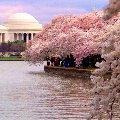Winter Gives a Hard Chop to Washington's Cherry Trees
This is the VOA Special English Agriculture Report.
Official snowfall records for Washington date back to eighteen eighty-four. By early February, this winter had already broken them with one hundred forty-two centimeters of snow measured.
But the recent storms that buried the city broke more than seasonal records. Heavy snow and high winds damaged some of Washington's famous cherry trees. In the spring, crowds expect a beautiful show as the trees blossom along the edge of the Tidal Basin next to the Jefferson Memorial.
Workers have been busy picking up broken branches, some as thick as fifteen centimeters. A few trees have lost their canopies.
Peak blooming, when the trees are in full flower, may be delayed a little. But the National Park Service says people can expect the usual show of pink and white flowers. This year's National Cherry Blossom Festival is set for March twenty-seventh through April fourth. Twelve kinds of cherry trees grow around the Tidal Basin. The first trees were a gift from Japan in nineteen twelve. The Japanese later sent two more gifts of cherry trees.
Cherry trees are valued for their flowers but also for their wood and their fruit. The United States and Turkey are leading producers of cherries, though not all cherry trees produce fruit.
The two major kinds of cherries are sweet and sour. Sour cherries, sometimes called tart cherries, are used in foods and drinks.
The state of Michigan is the nation's top producer of sour cherries. Washington -- not the city, but the state in the Pacific Northwest -- is the top producer of sweet cherries.
Now speaking of Washington and cherry trees, maybe you have heard the story about America's first president. As a boy George Washington supposedly told his father: "I cannot tell a lie. I chopped down the cherry tree." Is the story true? "Probably not," says the Web site for his home at Mount Vernon, Virginia. Monday was George Washington's birthday. But not much is known about his childhood. So it seems that a biography written shortly after his death included several invented stories about his early life. These were meant to show where he got his heroic qualities. Children then learned the story of the cherry tree in a school book, and it became rooted in popular history.
And that's the VOA Special English Agriculture Report, written by Jerilyn Watson. Transcripts, MP3s and captioned videos of our reports can be found at voaspecialenglish.com. You can also practice your English by posting comments. I'm Mario Ritter.

